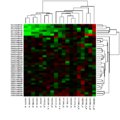Gene expression profiling
Gene Expression Profiling is a molecular biology technique for measuring the expression levels of thousands of genes simultaneously to understand cellular functions. This process involves the collection and analysis of transcriptome data from a sample of cells. Gene expression profiling has revolutionized the way researchers study diseases, particularly cancer, by providing insights into the molecular underpinnings of disease states, predicting disease progression, and identifying potential therapeutic targets.
Overview[edit]
Gene expression profiling assesses the activity of genes in a cell at a specific time. This activity is a reflection of the mRNA levels produced during gene expression, providing a snapshot of the cellular processes occurring at the time of analysis. The technique utilizes various platforms, including microarray technology and next-generation sequencing (NGS), with RNA sequencing (RNA-Seq) being the most comprehensive method.
Techniques[edit]
Microarrays[edit]
Microarrays involve hybridizing cDNA or cRNA samples to probes arrayed on a solid surface. Each probe corresponds to a gene, allowing for the simultaneous measurement of thousands of genes. The intensity of the signal from each probe indicates the expression level of the corresponding gene.
RNA Sequencing[edit]
RNA sequencing (RNA-Seq) uses next-generation sequencing technologies to sequence cDNA. This approach not only quantifies gene expression levels but also detects novel transcripts, alternative splicing events, and mutations. RNA-Seq provides a more detailed and comprehensive analysis of the transcriptome compared to microarrays.
Applications[edit]
Gene expression profiling has a wide range of applications in biomedical research and clinical diagnostics:
- Disease Diagnosis and Prognosis: Identifying specific gene expression patterns associated with diseases can aid in diagnosis and prognosis. For example, in cancer, gene expression profiles can distinguish between tumor types and predict patient outcomes.
- Drug Discovery and Development: By understanding the changes in gene expression in response to drug treatment, researchers can identify potential drug targets and assess drug efficacy.
- Personalized Medicine: Gene expression profiling enables the tailoring of medical treatment to the individual characteristics of each patient's disease, improving treatment outcomes.
Challenges and Future Directions[edit]
Despite its potential, gene expression profiling faces challenges, including the complexity of data analysis and interpretation, the need for high-quality sample preparation, and the cost of high-throughput technologies. Future advancements in computational biology and bioinformatics are expected to address these challenges, further enhancing the utility of gene expression profiling in research and clinical settings.
See Also[edit]
Gene expression profiling[edit]
Ad. Transform your life with W8MD's Budget GLP-1 injections from $75


W8MD offers a medical weight loss program to lose weight in Philadelphia. Our physician-supervised medical weight loss provides:
- Weight loss injections in NYC (generic and brand names):
- Zepbound / Mounjaro, Wegovy / Ozempic, Saxenda
- Most insurances accepted or discounted self-pay rates. We will obtain insurance prior authorizations if needed.
- Generic GLP1 weight loss injections from $75 for the starting dose.
- Also offer prescription weight loss medications including Phentermine, Qsymia, Diethylpropion, Contrave etc.
NYC weight loss doctor appointmentsNYC weight loss doctor appointments
Start your NYC weight loss journey today at our NYC medical weight loss and Philadelphia medical weight loss clinics.
- Call 718-946-5500 to lose weight in NYC or for medical weight loss in Philadelphia 215-676-2334.
- Tags:NYC medical weight loss, Philadelphia lose weight Zepbound NYC, Budget GLP1 weight loss injections, Wegovy Philadelphia, Wegovy NYC, Philadelphia medical weight loss, Brookly weight loss and Wegovy NYC
|
WikiMD's Wellness Encyclopedia |
| Let Food Be Thy Medicine Medicine Thy Food - Hippocrates |
Medical Disclaimer: WikiMD is not a substitute for professional medical advice. The information on WikiMD is provided as an information resource only, may be incorrect, outdated or misleading, and is not to be used or relied on for any diagnostic or treatment purposes. Please consult your health care provider before making any healthcare decisions or for guidance about a specific medical condition. WikiMD expressly disclaims responsibility, and shall have no liability, for any damages, loss, injury, or liability whatsoever suffered as a result of your reliance on the information contained in this site. By visiting this site you agree to the foregoing terms and conditions, which may from time to time be changed or supplemented by WikiMD. If you do not agree to the foregoing terms and conditions, you should not enter or use this site. See full disclaimer.
Credits:Most images are courtesy of Wikimedia commons, and templates, categories Wikipedia, licensed under CC BY SA or similar.
Translate this page: - East Asian
中文,
日本,
한국어,
South Asian
हिन्दी,
தமிழ்,
తెలుగు,
Urdu,
ಕನ್ನಡ,
Southeast Asian
Indonesian,
Vietnamese,
Thai,
မြန်မာဘာသာ,
বাংলা
European
español,
Deutsch,
français,
Greek,
português do Brasil,
polski,
română,
русский,
Nederlands,
norsk,
svenska,
suomi,
Italian
Middle Eastern & African
عربى,
Turkish,
Persian,
Hebrew,
Afrikaans,
isiZulu,
Kiswahili,
Other
Bulgarian,
Hungarian,
Czech,
Swedish,
മലയാളം,
मराठी,
ਪੰਜਾਬੀ,
ગુજરાતી,
Portuguese,
Ukrainian

